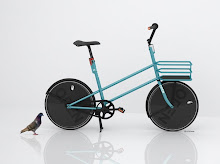 Transportation for America wants people in the U.S. to send this letter:Dear Secretary LaHood, I am alarmed by the continually high pedestrian fatality rate in this country.
Transportation for America wants people in the U.S. to send this letter:Dear Secretary LaHood, I am alarmed by the continually high pedestrian fatality rate in this country.
Just this week, a new study by the Surface Transportation Policy Partnership and Transportation for America reported that in the last 15 years, more than 76,000 Americans have been killed while crossing or walking along a street in their community. Overwhelmingly, these deaths occurred on poorly designed roadways that encouraged speeding cars and made little or no provision for people on foot, in wheelchairs, or on a bicycle.
The study shows the strong correlation between a metro area's Pedestrian Danger Index (PDI) and its spending on pedestrian safety projects. The metro areas in greatest need of improvement are spending the least.
The study also shows how many communities are creating safer streets - by making sure that every road project provides for the safety of everyone who will be using the road, including pedestrians. More than 100 communities across the country have adopted Complete Streets policies to do just that.Nationwide, less than 1.5 percent of funds authorized under the federal transportation law, SAFETEA-LU, have been spent on projects to improve the safety of walking and bicycling. Yet pedestrians comprise 11.8 percent of all traffic deaths and trips made on foot account for almost 9 percent of total trips.
Your work on combating distracted driving and establishing a new Safety Council shows that you are passionate about transportation safety. Please add to that record of achievement by supporting Complete Streets policy adoption across the country. This is a strategy that will not only can make our streets safer, but will help make our communities more livable by providing people with attractive transportation options.
We need your leadership on Complete Streets with Congress and within USDOT.
Sincerely, (Your signature)to which I say:
(to the tune of your favourite rap or folk song...)
Some had the space for a horse for a rideOr trees so the neighbours and birds could hideOn others all agreed bikes could be riddenOr a tram to sit in when you want your legs hidden
Streets were complete before cars came alongThe sidewalks so wide you could dance your own songThe sidewalks so proud that they met in the middleThe compromised think that this must be a riddle.
***
"Better", "Slower" are qualitative and acceptable; "Streets for People" used elsewhere, is vague but might be okay, but please ask yourself:
* Don't these terms mean something different than "complete"?
* What about the noise and tailpipe emissions of motor vehicles, in particular private cars... they also share the street, and not in a nice way.
* Why pretend to treat everyone equally regarding safety?
* Just how much does this encourage "alternative" transport? (Probably a bit to a bunch, depending on the quality of complementary measures... so that's good.)
"Complete", re-contextualised to include private urban cars, sends a strong signal that this subgroup of automobiles (which can be appropriately used) will be a permanent feature of the built environment -- that it deserves a place as much as other modes.
So, it's a pity that local authorities are confused (and confusers), and it's a shame that various community and advocacy organizations - such as "Transportation for America [sic]" which has an otherwise decent agenda - push this new kind of "complete". It is deceptive... even Orwellian language. If enshrined as law it's very, very dangerous.







